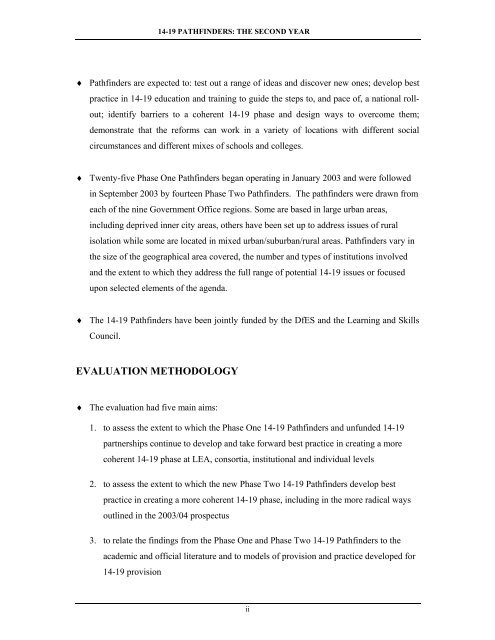Collaborative Approaches to 14-19 Provision - Communities and ...
Collaborative Approaches to 14-19 Provision - Communities and ...
Collaborative Approaches to 14-19 Provision - Communities and ...
- No tags were found...
Create successful ePaper yourself
Turn your PDF publications into a flip-book with our unique Google optimized e-Paper software.
<strong>14</strong>-<strong>19</strong> PATHFINDERS: THE SECOND YEAR♦ Pathfinders are expected <strong>to</strong>: test out a range of ideas <strong>and</strong> discover new ones; develop bestpractice in <strong>14</strong>-<strong>19</strong> education <strong>and</strong> training <strong>to</strong> guide the steps <strong>to</strong>, <strong>and</strong> pace of, a national rollout;identify barriers <strong>to</strong> a coherent <strong>14</strong>-<strong>19</strong> phase <strong>and</strong> design ways <strong>to</strong> overcome them;demonstrate that the reforms can work in a variety of locations with different socialcircumstances <strong>and</strong> different mixes of schools <strong>and</strong> colleges.♦ Twenty-five Phase One Pathfinders began operating in January 2003 <strong>and</strong> were followedin September 2003 by fourteen Phase Two Pathfinders. The pathfinders were drawn fromeach of the nine Government Office regions. Some are based in large urban areas,including deprived inner city areas, others have been set up <strong>to</strong> address issues of ruralisolation while some are located in mixed urban/suburban/rural areas. Pathfinders vary inthe size of the geographical area covered, the number <strong>and</strong> types of institutions involved<strong>and</strong> the extent <strong>to</strong> which they address the full range of potential <strong>14</strong>-<strong>19</strong> issues or focusedupon selected elements of the agenda.♦ The <strong>14</strong>-<strong>19</strong> Pathfinders have been jointly funded by the DfES <strong>and</strong> the Learning <strong>and</strong> SkillsCouncil.EVALUATION METHODOLOGY♦ The evaluation had five main aims:1. <strong>to</strong> assess the extent <strong>to</strong> which the Phase One <strong>14</strong>-<strong>19</strong> Pathfinders <strong>and</strong> unfunded <strong>14</strong>-<strong>19</strong>partnerships continue <strong>to</strong> develop <strong>and</strong> take forward best practice in creating a morecoherent <strong>14</strong>-<strong>19</strong> phase at LEA, consortia, institutional <strong>and</strong> individual levels2. <strong>to</strong> assess the extent <strong>to</strong> which the new Phase Two <strong>14</strong>-<strong>19</strong> Pathfinders develop bestpractice in creating a more coherent <strong>14</strong>-<strong>19</strong> phase, including in the more radical waysoutlined in the 2003/04 prospectus3. <strong>to</strong> relate the findings from the Phase One <strong>and</strong> Phase Two <strong>14</strong>-<strong>19</strong> Pathfinders <strong>to</strong> theacademic <strong>and</strong> official literature <strong>and</strong> <strong>to</strong> models of provision <strong>and</strong> practice developed for<strong>14</strong>-<strong>19</strong> provisionii
















